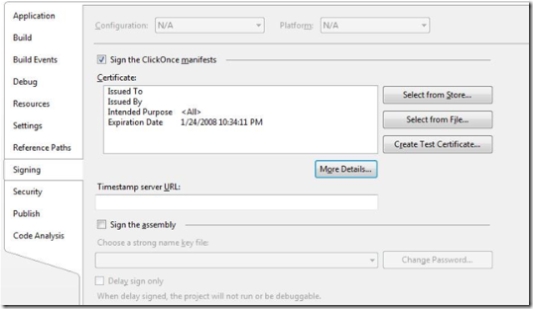Create your own .pfx file for ClickOnce
When you use ClickOnce to deploy your application with Visual Studio, a .pfx file is automatically generated by default.
Reminder:
When you want to use Authenticode signing, you need:
· A public key (.cer file) which is given by a Certificate Authority (trusted third party)
· A private Key (.pvk file) that you generate and you keep confidential
A Personal Information Exchange (pfx file) contains a public key and a private key. You can use it to hash your files (binary, assembly …) and even signed your manifest file for ClickOnce.
If you want to create your own PFX file with your personal information, you have to complete these two steps:
Create your public & private Keys (You will be prompt to define the private key’s password):
makecert.exe -sv MyKey.pvk -n "CN=.NET Ready!!!" MyKey.cer
Create your PFX file from the public and private key
pvk2pfx.exe -pvk MyKey.pvk -spc MyKey.cer -pfx MyPFX.pfx -po toto
Now that you have your PFX file, you can sign your application with mage or mageUI:
With Mage:
Sign the application manifest
mage -sign MyApplication _1_0_0_0\ MyApplication.exe.manifest -CertFile Test.pfx -pwd "toto"
With :
MyApplication _1_0_0_0\ MyApplication.exe.manifest :application manifest
Test.pfx : pfx file (include the private and public keys)
toto= password
Update the deployment manifest with the application manifest
mage -update MyApplication.application –AppManifest MyApplication _1_0_0_0\ MyApplication.exe.manifest
With :
MyApplication.application : deploy manifest
MyApplication _1_0_0_0\ MyApplication.exe.manifest : application manifest
Sign the deployment manifest
mage -sign MyApplication.application -CertFile Test.pfx -pwd "toto"
With :
MyApplication.application : deploy manifest
Test.pfx : pfx file (include the private and public keys)
toto= password
With MageUI:
Or your can define your certificate to sign your ClickOnce manifest in Visual Studio (before deployment):
Now, your application will be deployed with your certificate ;-)
Have Fun !!!
Comments
Anonymous
April 02, 2007
This article really made my day :) Thanks!!Anonymous
June 04, 2007
Merci bien Maxime, c'était parfait!Anonymous
September 23, 2007
Based on a recent inquiry, I have compiled the following, simple How-To on digitally signing Vista SidebarAnonymous
October 17, 2007
Just Wow, Gr8 workAnonymous
January 24, 2008
I want To change the formula from jpg to pfxAnonymous
May 22, 2008
How to increase the expire date of the pfx fileAnonymous
June 01, 2008
This is required for testing purpose. Required for development.Anonymous
June 06, 2008
Thank you for this great article. It really helped me resolve my isssue... THanks.Anonymous
July 08, 2008
I hope you haven't gotten sick of people thanking you yet, but... THANK YOU! I spent the last few hours trying to understand the MSDN, and then I stumbled over this blog which answered everything. You're awesome.Anonymous
August 22, 2008
I see that in your example, you set the X509name to "CN=.NET Ready!!!". Ok, but what does it mean? I've looked around and I get some vague answers like from Wikipidia: "Its subject contains many personal details, but the most important part is usually the common name (CN), as this is the part that must match the host being authenticated." (http://en.wikipedia.org/wiki/X.509) But how is it matched? Giving some other examples I've seen, it looks like that string can be anything anyway. So why even bother?Anonymous
August 22, 2008
I see that in your example, you set the X509name to "CN=.NET Ready!!!". Ok, but what does it mean? I've looked around and I get some vague answers like from Wikipidia: "Its subject contains many personal details, but the most important part is usually the common name (CN), as this is the part that must match the host being authenticated." (http://en.wikipedia.org/wiki/X.509) But how is it matched? Giving some other examples I've seen, it looks like that string can be anything anyway. So why even bother?Anonymous
August 27, 2008
Someone can send me the pvk2pfx.exe i've lost from my drive to dcolumbich@hotmail.com. Thank you.Anonymous
November 10, 2008
Someone can send me the pvk2pfx.exe to bobkoalexander@gmail.com. Thank you.Anonymous
November 12, 2008
All good, but now how can you keep you chaining intact. the p7b aka PCKS#7 file contains chaining information. The method of signing you just described doesnt accomidate chaining. Any ideas people?Anonymous
November 26, 2008
Remark : If you’re not using FinalBuilder but plain MSBuild, you can most likely benefit from the tutorialAnonymous
December 29, 2008
nice post. what i have been searching for. Keep it up!Anonymous
January 01, 2009
I wonder why MSDN cannot be less confusing. Thanks.Anonymous
May 04, 2009
Thank you for information that is simple and to the point. I like your example, not too much but it fully illustrates the process well! Thank you again!Anonymous
July 22, 2009
am from india......ur article is really helpful.......thanks for online chat help.....Anonymous
February 15, 2010
You explained it in very simple and useful way Thanks very much. It helped me lotAnonymous
March 25, 2010
i want a pfx file, how to createAnonymous
July 10, 2010
Can some one send me the pvk2pfx.exe to me. My email id is vinayarali@gmail.comAnonymous
January 14, 2011
Thank you so much! Finally someone who could explain how it works.Anonymous
July 31, 2011
It's a really useful info. Thanks.Anonymous
January 30, 2013
How can get max deploy .exe please provide me linkAnonymous
August 15, 2013
sir plz How can get max deploy .exe please provide me linkAnonymous
August 21, 2013
how to get tha max deplo.exe provide me the link

